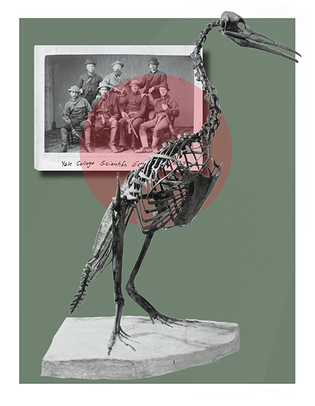
Photos courtesy Yale Peabody Museum of Natural History
Thomas Russell 1872PhB, 1875MD (at far left in the photograph), was the first to discover a skull of the ancient toothed bird Hesperornis regalis. Russell was on an expedition organized by Professor O. C. Marsh 1860, 1862MA (at center in photo, holding a rock hammer). The discovery made Hesperornis, for a while, a star.
View full image
This October 27th marks the sesquicentennial of the discovery of one of the Peabody Museum’s most significant specimens: a fossilized partial skeleton, over three feet tall, of the ancient toothed bird Hesperornis regalis. It was discovered on October 27, 1872, by Thomas Russell 1872PhB, 1875MD, in the 85-million-year-old chalk beds of Kansas.
Russell, who had just graduated, was part of a Yale College Scientific Expedition—the third of four that would be led by Yale professor O. C. Marsh 1860, 1862MA, who would later name Triceratops, Brontosaurus, Stegosaurus, pterosaurs, and many others. Marsh was seeking fossils in the exposed, arid land of the American West. They had already collected an incomplete skeleton of a large fossil seabird in the same area in 1871; Marsh had named it Hesperornis regalis, meaning “regal western bird.” Unfortunately, that specimen, and four others found early on, lacked their skulls. Marsh nevertheless deduced that Hesperornis was a large, flightless, foot-propelled swimmer and diver, an idea still supported today. But he had no way of knowing the full evolutionary significance.
What Russell discovered were the first partial remains of Hesperornis that included bones of a skull. The skeletal remains of this fossil (aka YPM VP.001206) were pried out of the Kansas chalk in slabs and displayed at the Peabody, its bones exposed in bas-relief. Later, in the early 1910s, most of the bones were removed from the chalk and mounted in a standing pose; they remained on display until the Peabody’s renovation began in 2020. The skull on the mount is, however, a sculpted model. The actual skull bones remained partially embedded in chalk until 1971, when they were removed to facilitate further research.
Although Hesperornis was not the first toothed bird recognized by Marsh, it became, for a time, the most renowned. Reconstructions appeared on wall charts in classrooms and museums around the world. Marsh and, later, Ward’s Natural Science Establishment distributed plaster casts of several of its bones, including a toothed jaw fragment. Marsh’s toothed birds were widely recognized as evidence for Darwinian evolution. After receiving a presentation copy of Marsh’s monograph Odontornithes, in 1880, Charles Darwin himself wrote to Marsh: “Your work on these old birds + on the many fossil animals of N. America has afforded the best support to the theory of evolution, which has appeared within the last 20 years”—in other words, ever since Darwin published On the Origin of Species.
Over a decade before Russell’s crucial find, the discovery of Archaeopteryx, the feathered “transitional fossil,” had initiated a spirited debate on the evolutionary origin of birds. It lasted well over a century. In 1873, two years before Marsh described the Hesperornis skull, he wrote of his other toothed birds that “the fortunate discovery of these interesting fossils . . . does much to break down the old distinctions between Birds and Reptiles, which the Archaeopteryx has so materially diminished.” Others had already proposed evolutionary affinities between dinosaurs and birds, but these proposals did not gain traction until the 1970s, when Yale paleontologist John Ostrom took them one step further by describing, in a series of landmark papers, the detailed anatomical similarities between a group of small, predatory, bipedal dinosaurs and Archaeopteryx—thereby establishing the direct evolutionary link between dinosaurs and birds.
Subsequent research, much of it done in the last 40 years by Yale faculty and alumni, has built upon Ostrom’s meticulous work. We now know that birds evolved from some small, feathered, predacious species of bipedal dinosaur with forelimbs that could grab; and that it was a close, albeit older, cousin to Deinonychus, the notorious “raptor” dinosaur named by Ostrom in 1969. Since birds evolved from a species of dinosaur, all birds, including Hesperornis, are dinosaurs as well.
Therefore, not all dinosaurs went extinct 66 million years ago. By some estimates, around 18,000 species of dinosaurs are still alive today.
As for Thomas Russell, he would be proud to know that his great-granddaughter, Jill Hunting, wrote about his find in her book For Want of Wings: A Bird With Teeth and a Dinosaur in the Family. David Skelly, director of the Peabody, has written: “As [Hunting] notes, Hesperornis is perhaps the least famous of the most important fossils ever discovered. Her book should change that.”
 loading
loading